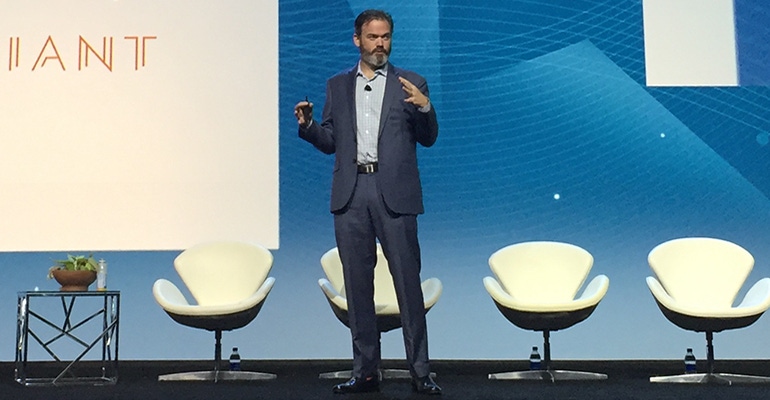The typical business owner doesn't know enough about their books to do anything other than look at the net bottom line.

CHANNEL PARTNERS EVOLUTION — As an MSP, what does gross margin mean to you?
It could be the key to greater efficiency, improved service and more revenue if you look at it beyond just the net bottom line. During his Channel Partners Evolution keynote, Thomas Clancy, CEO of Valiant Technology, shared what he has learned about gross margin and how focusing on it has transformed his business.
Among Valiant’s services are cloud migration and disaster recovery.
The typical “accidental business owner” doesn’t know enough about their books to do anything other than look at the net bottom line, Clancy said.
“I know that I resisted looking at gross margin because frankly I didn’t understand it,” he said. “Once I understood the value of it, I actually recognized that by having a checkpoint along the path, I could segregate what it costs to deliver my service product versus what it cost to operate my business. And I could see in which section of my business I was overinvesting or underinvesting. That’s really the power of gross margin, it just gives you a little bit of clarity and adjusts the focus so that you have an opportunity to look at service and operations, and keep them separate.”
It’s critical for MSPs to maintain “great” gross margin because that’s what makes your business healthy, and it also makes your business attractive if you’re interested in an exit strategy that revolves around acquisition, Clancy said.
“One of the places that they’re going to be looking at is your gross margin because let’s face it, during an acquisition, they’re not looking to buy your business and leave it exactly as it is,” he said. “They’re looking to buy your business and absorb it into their own, and what is it that they’re going to be able to cut or adapt, or adjust or remove, or make redundant. They’re only going to be able to know by looking at things like your gross margin.”
Handling gross margin differently isn’t difficult, but it’s time consuming, Clancy said. It takes a lot of time to get your books organized, he said.
“The easier part is actually just making a decision about what falls into the cost of goods sold and what doesn’t,” he said. “The nice thing is you really can’t do it wrong. You just have to do it, stick with it over a period, and if you end up deciding that you have to make an adjustment to what falls above or below the line, you can always retroactively move things from one category to another, and re-review your reports to see what the impact is. I know that we are constantly making slight adjustments to how we measure things, which portion of payroll is in which bucket, because it seems to make a lot more sense and as we get more educated, we just make the change.”
With a singular view of gross margin, “we had no way of knowing necessarily whether or not our business was healthy, our service department was healthy, our sales investment was appropriate and our marketing investment was appropriate,” Clancy said. The accountant’s job was just to “make sure we were keeping our taxable profit footprint fairly light,” he said.
“When we segregated, we were able to see fairly quickly that we were actually overinvested in a couple of places in our service team and we made adjustments to make it right,” he said. “Thankfully it wasn’t a layoff situation, it was just sort of a not replacing people as they cycled out, which was great. And the result was also then service levels did not decrease when we decreased the staff in the service department and we actually had additional budget that we could invest in other areas of the business that are now paying us a great dividend. It made a huge difference.”
About the Author(s)
You May Also Like


